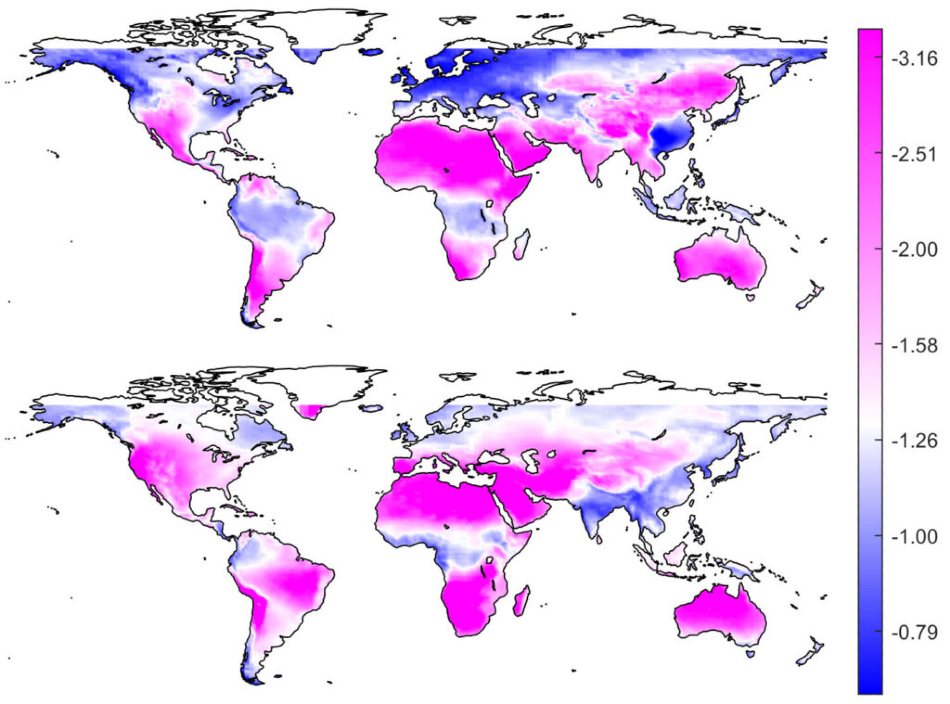Oct 8 2020
Although solar power is considered a popular form of renewable energy, a new study reports that deviations in regional climates due to global warming could render areas currently deemed suitable for the production of solar energy less feasible in the future.

Image Credit: Jun Yin, Nanjing University of Information Science and Technology.
Princeton-based scientists are involved in the first-ever study to evaluate the day-to-day reliability of solar energy under climate change. Details of their research have been published in the Nature Communications journal. The researchers used climate models and satellite data to show how sunlight reaching Earth would be influenced as warmer global temperatures change the consistency and dynamics of Earth’s atmosphere.
Their research discovered that higher surface temperatures—and the ensuing increase in the amount of aerosols, moisture, and particulates in the air—may result in a complete decrease in solar radiation and an increase in the number of cloudy days. Hot, dry regions such as the American Southwest and the Middle East—said to be among the highest potential producers of solar power—were most vulnerable to greater variations in sunlight, the team learned.
Our results could help in designing better solar power plants and optimizing storage while also avoiding the expansion of solar power capacity in areas where sunlight intermittency under future climate conditions may be too high to make solar reliable.
Amilcare Porporato, Study Corresponding Author and Thomas J. Wu ’94 Professor of Civil and Environmental Engineering and Princeton Environmental Institute, Princeton University
The study received support from the Carbon Mitigation Initiative based in PEI.
To use an academic metaphor, in terms of solar power, semiarid places are now like students who get an A nearly every day. Now, climate change is disturbing the usual dynamics of the atmosphere and the regularity of the solar radiation reaching the planet’s surface. We tried to quantify how much more often those A’s could become B’s, or even C’s, as a result.
Amilcare Porporato, Study Corresponding Author and Thomas J. Wu ’94 Professor of Civil and Environmental Engineering and Princeton Environmental Institute, Princeton University
The focus of contemporary research on how solar energy will fare in this uncertain future has been mainly on average sunlight levels, noted first author Jun Yin, a researcher at Nanjing University of Information Science and Technology who assisted on the paper at Princeton as a postdoctoral research associate with Porporato.
“The novelty of our approach was to point out that in some places there is going to be more uncertainty in day-to-day variability,” Yin added.
He and Porporato earlier reported that climate models undervalue the cooling effect of the day-to-day cloud cycle. Besides Yin and Porporato, Annalisa Molini, an associate professor of civil infrastructure and environmental engineering at Khalifa University in the United Arab Emirates, also worked on the most recent paper as co-author.
The study results were founded on probabilistic calculations matching those used to establish the hazard of drought or flooding. The reduced dependability of solar energy is associated with the increased unpredictability of atmospheric aerosols and moisture in some dry regions.
Higher temperatures retain more moisture and are more unstable, which is propitious for cloud formation and maintains particles in suspension for a longer period, Porporato explained.
“Then there is the issue of soils drying, which may be even more important,” Porporato added. As atmospheric turbulence and temperatures increase in dry regions such as the Middle East, dry soils possibly cause higher amounts of atmospheric aerosols and dust that would reduce solar radiation. These trends were actually already detected in studies from climate-observation networks, Porporato noted.
The team’s findings for the American Southwest were not so consistent. A few models exhibited lower intermittency and more solar radiation in the future, while others exhibited higher intermittency and less solar radiation. These results denote the difficulties associated with attempting to predict the dependability of solar energy in an unsure future, stated Yin.
We hope that policymakers and people in the energy industry can take advantage of this information to more efficiently design and manage photovoltaic facilities. Our paper helps identify efficient solutions for different locations where intermittency could occur, but at an acceptable level. A variety of technologies such as power storage, or power-operation policies such as smart curtailment, load shaping or geographical dispersion, are promising solutions.
Jun Yin, Study First Author and Researcher, Nanjing University of Information Science and Technology
Going forward, the team plans to study climate persistency—particularly, the number of consecutive cloudy or sunny days—which is crucial for solar energy. They will also look at how clouds could influence the effectiveness of tree planting as a climate mitigation approach.
Trees take in not only carbon dioxide but also solar energy, which would increase surface temperatures. A subsequent increase in cloud coverage could alter current estimates of how effective trees would be in decreasing atmospheric carbon.
The research was financially supported by the USDA Agricultural Research Service (grant no. 58-6408-3-027), Nanjing University of Information Science and Technology (grant no. 1441052001003), the National Science Foundation (grant nos. EAR-1331846, EAR-1316258 and FESD EAR-1338694), the Jiangsu distinguished faculty program, the PEI Carbon Mitigation Initiative, the National Natural Science Foundation of China (grant nos. 41877158 and 51739009), and the Khalifa University Competitive Internal Research Award (grant no. CIRA-2018-102).
Journal Reference:
Yin, J., et al. (2020) Impacts of solar intermittency on future photovoltaic reliability. Nature Communications. doi.org/10.1038/s41467-020-18602-6.